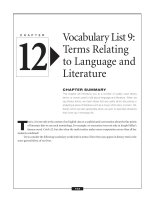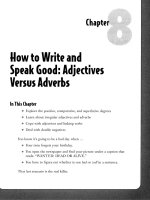FM11 Ch 18 Distributions to Shareholders_Dividends and Repurchases
Bạn đang xem bản rút gọn của tài liệu. Xem và tải ngay bản đầy đủ của tài liệu tại đây (106.89 KB, 29 trang )
18 - 1
CHAPTER 18
Distributions to Shareholders:
Dividends and Repurchases
Theories of investor preferences
Signaling effects
Residual model
Stock repurchases
Stock dividends and stock splits
Dividend reinvestment plans
18 - 2
What is “distribution policy”?
The distribution policy defines:
The level of cash distributions to
shareholders
The form of the distribution
(dividend vs. stock repurchase)
The stability of the distribution
18 - 3
Dividend Yields for Selected Industries
Industry Div. Yield %
Airline 0.2
Software & Programming 0.3
Biotechnology & Drugs 0.3
Restaurants 1.0
Chemical Manufacturing 2.2
Paper & Paper Products 2.7
Electric Utilities 4.4
Tobacco 5.6
Source: Yahoo Industry Data
18 - 4
Do investors prefer high or low
payouts? There are three theories:
Dividends are irrelevant: Investors don’t
care about payout.
Bird-in-the-hand: Investors prefer a high
payout.
Tax preference: Investors prefer a low
payout, hence growth.
18 - 5
Dividend Irrelevance Theory
Investors are indifferent between dividends
and retention-generated capital gains. If they
want cash, they can sell stock. If they don’t
want cash, they can use dividends to buy
stock.
Modigliani-Miller support irrelevance.
Theory is based on unrealistic assumptions
(no taxes or brokerage costs), hence may not
be true. Need empirical test.
18 - 6
Bird-in-the-Hand Theory
Investors think dividends are less risky
than potential future capital gains, hence
they like dividends.
If so, investors would value high payout
firms more highly, i.e., a high payout
would result in a high P
0
.
18 - 7
Tax Preference Theory
Low payouts mean higher capital gains.
Capital gains taxes are deferred.
This could cause investors to prefer
firms with low payouts, i.e., a high
payout results in a low P
0
.
18 - 8
Implications of 3 Theories for
Managers
Theory Implication
Irrelevance Any payout OK
Bird-in-the-hand Set high payout
Tax preference Set low payout
18 - 9
Which theory is most correct?
Empirical testing has not been able to
determine which theory, if any, is
correct.
Thus, managers use judgment when
setting policy.
Analysis is used, but it must be applied
with judgment.
18 - 10
What’s the “clientele effect”?
Different groups of investors, or clienteles,
prefer different dividend policies.
Firm’s past dividend policy determines its
current clientele of investors.
Clientele effects impede changing dividend
policy. Taxes & brokerage costs hurt
investors who have to switch companies due
to a change in payout policy.
18 - 11
What’s the “information content,” or
“signaling,” hypothesis?
Investors view dividend changes as signals of
management’s view of the future. Managers
hate to cut dividends, so won’t raise
dividends unless they think raise is
sustainable.
Therefore, a stock price increase at time of a
dividend increase could reflect higher
expectations for future EPS, not a desire for
dividends.
18 - 12
What’s the “residual distribution
model”?
Find the reinvested earnings needed for
the capital budget.
Pay out any leftover earnings (the
residual) as either dividends or stock
repurchases.
This policy minimizes flotation and
equity signaling costs, hence minimizes
the WACC.
18 - 13
Using the Residual Model to Calculate
Distributions Paid
Distr. = – .
Net
income
Target
equity
ratio
Total
capital
budget
[ ]
)
)((
18 - 14
Data for SSC
Capital budget: $800,000. Given.
Target capital structure: 40% debt, 60%
equity. Want to maintain.
Forecasted net income: $600,000.
If all distributions are in the form of
dividends, how much of the $600,000
should we pay out as dividends?
18 - 15
Of the $800,000 capital budget,
0.6($800,000) = $480,000 must be equity
to keep at target capital structure.
[0.4($800,000) = $320,000 will be debt.]
With $600,000 of net income, the residual
is $600,000 - $480,000 = $120,000 =
dividends paid.
Payout ratio = $120,000/$600,000
= 0.20 = 20%.
18 - 16
How would a drop in NI to $400,000
affect the dividend? A rise to
$800,000?
NI = $400,000: Need $480,000 of equity,
so should retain the whole $400,000.
Dividends = 0.
NI = $800,000: Dividends = $800,000 -
$480,000 = $320,000. Payout =
$320,000/$800,000 = 40%.
18 - 17
How would a change in investment
opportunities affect dividend under the
residual policy?
Fewer good investments would lead to
smaller capital budget, hence to a higher
dividend payout.
More good investments would lead to a
lower dividend payout.
18 - 18
Advantages and Disadvantages of the
Residual Dividend Policy
Advantages: Minimizes new stock issues and
flotation costs.
Disadvantages: Results in variable
dividends, sends conflicting signals,
increases risk, and doesn’t appeal to any
specific clientele.
Conclusion: Consider residual policy when
setting target payout, but don’t follow it
rigidly.
18 - 19
Stock Repurchases
Reasons for repurchases:
As an alternative to distributing cash as
dividends.
To dispose of one-time cash from an asset
sale.
To make a large capital structure change.
Repurchases: Buying own stock back
from stockholders.
18 - 20
Advantages of Repurchases
Stockholders can tender or not.
Helps avoid setting a high dividend that
cannot be maintained.
Repurchased stock can be used in
takeovers or resold to raise cash as needed.
Income received is capital gains rather than
higher-taxed dividends.
Stockholders may take as a positive signal
management thinks stock is undervalued.
18 - 21
Disadvantages of Repurchases
May be viewed as a negative signal (firm has
poor investment opportunities).
IRS could impose penalties if repurchases
were primarily to avoid taxes on dividends.
Selling stockholders may not be well
informed, hence be treated unfairly.
Firm may have to bid up price to complete
purchase, thus paying too much for its own
stock.
18 - 22
Setting Dividend Policy
Forecast capital needs over a planning
horizon, often 5 years.
Set a target capital structure.
Estimate annual equity needs.
Set target payout based on the residual
model.
Generally, some dividend growth rate
emerges. Maintain target growth rate if
possible, varying capital structure
somewhat if necessary.
18 - 23
Stock Dividends vs. Stock Splits
Stock dividend: Firm issues new shares
in lieu of paying a cash dividend. If 10%,
get 10 shares for each 100 shares owned.
Stock split: Firm increases the number
of shares outstanding, say 2:1. Sends
shareholders more shares.
18 - 24
Both stock dividends and stock splits
increase the number of shares
outstanding, so “the pie is divided into
smaller pieces.”
Unless the stock dividend or split
conveys information, or is accompanied
by another event like higher dividends,
the stock price falls so as to keep each
investor’s wealth unchanged.
But splits/stock dividends may get us to
an “optimal price range.”
18 - 25
When should a firm consider splitting
its stock?
There’s a widespread belief that the optimal
price range for stocks is $20 to $80.
Stock splits can be used to keep the price
in the optimal range.
Stock splits generally occur when
management is confident, so are
interpreted as positive signals.









